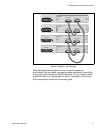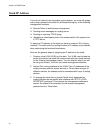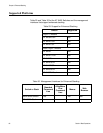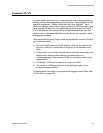
Chapter 2: AT-9400Ts Stacks
78 Section I: Basic Operations
Stack IP Address
If you do not intend to use the packet routing feature, you must still assign
one routing interface to the stack if it will be performing any of the following
management functions:
Remote Telnet or web browser management
Sending event messages to a syslog server
Sending or receiving TCP/IP pings
Uploading or downloading files to the master switch’s file system from
a TFTP server
To assign an IP address to the stack you have to create an IPv4 routing
interface. The stack uses the routing interface’s IP address as its address
when performing the functions listed above.
Here are the general steps to assigning an IP address to the stack:
1. Create a virtual LAN (VLAN) on the stack. The VLAN must include the
port(s) from where the stack will communicate with the remote servers
or the Telnet or web browser clients. You can skip this step if you will
be using the Default_VLAN for the remote management sessions.
2. Add an IPv4 routing interface to the VLAN. If the IP addresses of the
routing interface and the remote servers or Telnet clients are part of
different subnets, the subnets must be connected with Layer 3 routing
devices.
3. To manage the stack from a remote Telnet client, designate the
routing interface as the stack’s local interface with SET IP LOCAL
INTERFACE command. This instructs the management software to
monitor the subnet of the interface for the remote management
packets from the Telnet client.


















